
The orange clownfish also known as percula clownfish and clown anemonefish, is widely known as a popular aquarium fish. Like other clownfishes, it often lives in association with sea anemones. A. percula is associated specifically with Heteractis magnifica and Stichodactyla gigantea, and as larvae use chemical cues released from the anemones to identify and locate the appropriate host species to use them for shelter and protection. This causes preferential selection when finding their anemone host species. Although popular, maintaining this species in captivity is rather complex. The Great Barrier Reef Marine Park Authority regulates the number of collection permits issued to aquarium fish dealers who seek this, and other tropical fish within the Great Barrier Reef Marine Park. The symbiosis between anemonefish and anemones depends on the presence of the fish drawing other fish to the anemone, where they are stung by its venomous tentacles. The anemone helps the fish by giving it protection from predators, which include brittle stars, wrasses, and other damselfish, and the fish helps the anemone by feeding it, increasing oxygenation, and removing waste material from the host. Various hypotheses exist about the fish's ability to live within the anemone without being harmed. One study carried out at Marineland of the Pacific by Dr. Demorest Davenport and Dr. Kenneth Noris in 1958 revealed that the mucus secreted by the anemone fish prevented the anemone from discharging its lethal stinging nematocysts. A second hypothesis is that A. percula has acquired immunity towards the sea anemone's toxins, and a combination of the two has been shown to be the case. The fish feed on algae, zooplankton, worms, and small crustaceans.
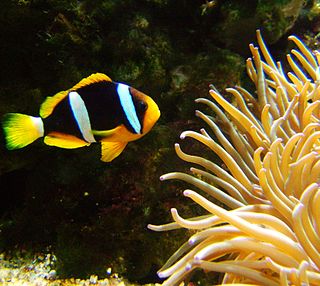
Amphiprion clarkii, known commonly as Clark's anemonefish and yellowtail clownfish, is a marine fish belonging to the family Pomacentridae, the clownfishes and damselfishes.
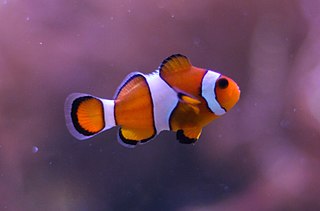
The ocellaris clownfish, also known as the false percula clownfish or common clownfish, is a marine fish belonging to the family Pomacentridae, which includes clownfishes and damselfishes. Amphiprion ocellaris are found in different colors, depending on where they are located. For example, black Amphiprion ocellaris with white bands can be found near northern Australia, Southeast Asia, and Japan. Orange or red-brown Amphiprion ocellaris also exist with three similar white bands on the body and head. Amphiprion ocellaris can be distinguished from other Amphiprion species based on the number of pectoral rays and dorsal spines. Amphiprion ocellaris are known to grow about 110 mm long. Like many other fish species, females are, however, larger than males. The life cycle of Amphiprion ocellaris varies in whether they reside at the surface or bottom of the ocean. When they initially hatch, they reside near the surface. However, when Amphiprion ocellaris enter into the juvenile stage of life, they travel down to the bottom to find shelter in a host anemone. Once they find their anemone, they form a symbiotic relationship with them.

The tomato clownfish is a species of marine fish in the family Pomacentridae, the clownfishes and damselfishes. It is native to the waters of the Western Pacific, from the Japan to Indonesia. Other common names include blackback anemonefish, bridled anemonefish, fire clown, and red tomato clown.

Amphiprion sandaracinos, also known as the orange skunk clownfish or orange anemonefish, is a species of anemonefish that is distinguished by its broad white stripe along the dorsal ridge. Like all anemonefishes it forms a symbiotic mutualism with sea anemones and is unaffected by the stinging tentacles of the host anemone. It is a sequential hermaphrodite with a strict sized based dominance hierarchy: the female is largest, the breeding male is second largest, and the male non-breeders get progressively smaller as the hierarchy descends. They exhibit protandry, meaning the breeding male will change to female if the sole breeding female dies, with the largest non-breeder becomes the breeding male.

Amphiprion sebae, also known as the sebae clownfish, is an anemonefish found in the northern Indian Ocean, from Java to the Arabian Peninsula. Like all anemonefish it is usually found living in association with sea anemones. While the common name of Heteractis crispa, the sebae anemone, suggests an association, it is normally found with the Stichodactyla haddoni or saddle anemone. A. sebae, like all anemonefish, lives in a symbiotic relationship with the host anemone where the fish is unaffected by the stinging tentacles of the anemone. In a group of clownfish, Only two clownfish, a male and a female, in a group reproduce through external fertilization. Clownfish are sequential hermaphrodites, changing from male to female, with a strict dominance hierarchy and only the largest fish being female.

The sebae anemone, also known as leathery sea anemone, long tentacle anemone, or purple tip anemone, is a species of sea anemone belonging to the family Stichodactylidae and native to the Indo-Pacific area.
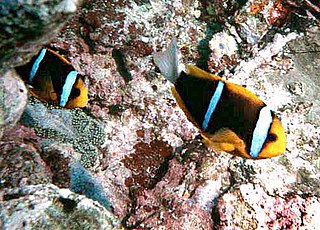
The orange-fin anemonefish is a marine fish belonging to the family Pomacentridae, the clownfishes and damselfishes, found in the Western Pacific north of the Great Barrier Reef from the surface to 20 m, to include the Pacific Ocean between Queensland, Australia, and New Guinea to the Marshall and Tuamotus Islands. It can grow to 17 cm in length.

Allard's clownfish or Allard's anemonefish is a marine fish belonging to the family Pomacentridae, the clownfishes and damselfishes, from the western Indian Ocean off the coast of East Africa and the Mascarenes.

Amphiprion polymnus, also known as the saddleback clownfish or yellowfin anemonefish, is a black and white species of anemonefish with a distinctive saddle. Like all anemonefishes it forms a symbiotic mutualism with sea anemones and is unaffected by the stinging tentacles of the host anemone. It is a sequential hermaphrodite with a strict sized-based dominance hierarchy: the female is largest, the breeding male is second largest, and the male non-breeders get progressively smaller as the hierarchy descends. They exhibit protandry, meaning the breeding male will change to female if the sole breeding female dies, with the largest non-breeder becomes the breeding male.

Amphiprion akindynos, the Barrier Reef anemonefish, is a species of anemonefish that is principally found in the Great Barrier Reef of Australia, but also in nearby locations in the Western Pacific. The species name 'akindynos' is Greek, meaning 'safe' or 'without danger' in reference to the safety afforded amongst the tentacles of its host anemone. Like all anemonefishes it forms a symbiotic mutualism with sea anemones and is unaffected by the stinging tentacles of the host anemone. It is a sequential hermaphrodite with a strict size-based dominance hierarchy: the female is largest, the breeding male is second largest, and the male non-breeders get progressively smaller as the hierarchy descends. They exhibit protandry, meaning the breeding male will change to female if the sole breeding female dies, with the largest non-breeder becomes the breeding male. The fish's natural diet includes zooplankton.

Amphiprion bicinctus, meaning "both sawlike with two stripes," commonly known as the Red Sea or two-bandedanemonefish is a marine fish belonging to the family Pomacentridae, the clownfishes and damselfishes. Like other species of the genus, the fish feeds on algae and zooplankton in the wild.

Amphiprion perideraion, also known as the pink skunk clownfish or the pink anemonefish, is a species of anemonefish that is widespread from northern Australia through the Malay Archipelago and Melanesia. Like all anemonefishes, it forms a symbiotic mutualism with sea anemones and is unaffected by the stinging tentacles of the host. It is a sequential hermaphrodite with a strict size-based dominance hierarchy; the female is largest, the breeding male is second largest, and the male nonbreeders get progressively smaller as the hierarchy descends. They exhibit protandry, meaning the breeding male changes to female if the sole breeding female dies, with the largest nonbreeder becoming the breeding male.
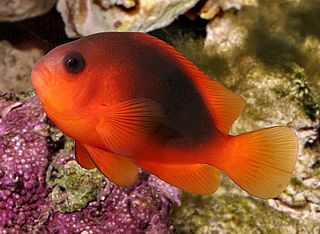
The red saddleback anemonefish, Amphiprion ephippium, also known as the saddle anemonefish, is a marine fish belonging to the family Pomacentridae, the clownfishes and damselfishes.
The three-band anemonefish is a species of anemonefish endemic to the Marshall Islands in the western part of the Pacific Ocean. Like all anemonefishes, it forms a symbiotic mutualism with sea anemones and is unaffected by the stinging tentacles of its host. It is a sequential hermaphrodite with a strict size-based dominance hierarchy; the female is largest, the breeding male is second largest, and the male nonbreeders get progressively smaller as the hierarchy descends. They exhibit protandry, meaning the breeding male changes to female if the sole breeding female dies, with the largest nonbreeder becoming the breeding male. The fish's natural diet includes zooplankton.

Stichodactyla gigantea, commonly known as the giant carpet anemone, is a species of sea anemone that lives in the Indo-Pacific area. It can be kept in an aquarium but is a very challenging species to keep alive and healthy for more than 3–5 years.
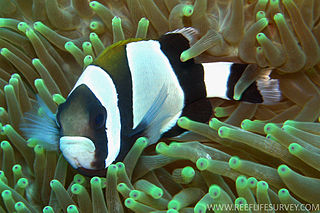
Amphiprion latezonatus, also known as the wide-band anemonefish, is a species of anemonefish found in subtropical waters off the east coast of Australia. Like all anemonefishes, it forms a symbiotic mutualism with sea anemones and is unaffected by the stinging tentacles of its host. It is a sequential hermaphrodite with a strict size-based dominance hierarchy; the female is largest, the breeding male is second largest, and the male nonbreeders get progressively smaller as the hierarchy descends. They exhibit protandry, meaning the breeding male changes to female if the sole breeding female dies, with the largest nonbreeder becoming the breeding male.

Amphiprion chagosensis, the Chagos anemonefish, is a marine fish belonging to the family Pomacentridae, the clownfishes and damselfishes. It is named for the Chagos Archipelago in the Indian Ocean and it is endemic to the archipelago. The original specimens were collected at Diego Garcia Atoll, Chagos Archipelago.

Amphiprion fuscocaudatus is a marine fish belonging to the family Pomacentridae, the clownfishes and damselfishes.
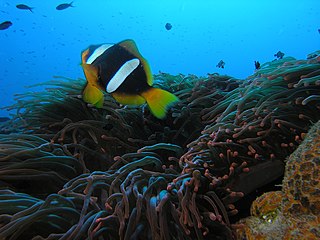
Amphiprion latifasciatus is a marine fish belonging to the family Pomacentridae, the clownfishes and damselfishes.





























